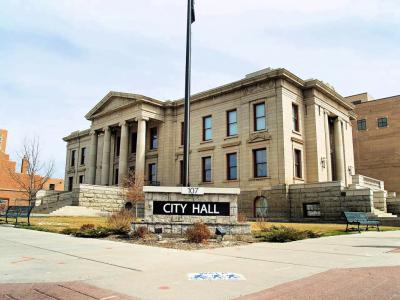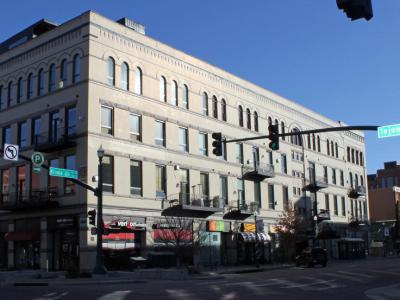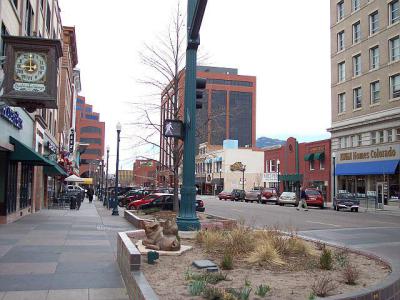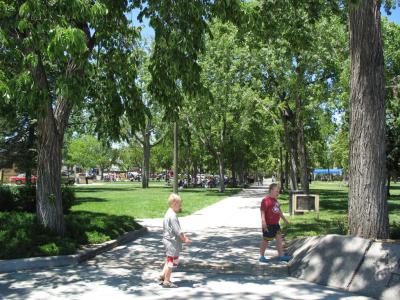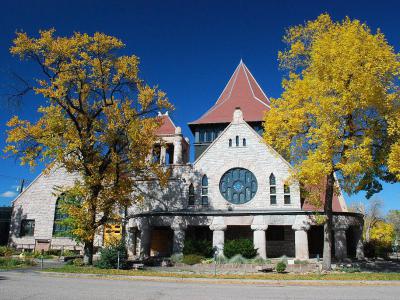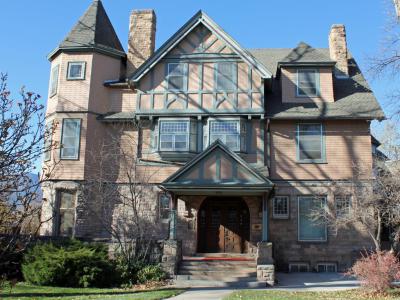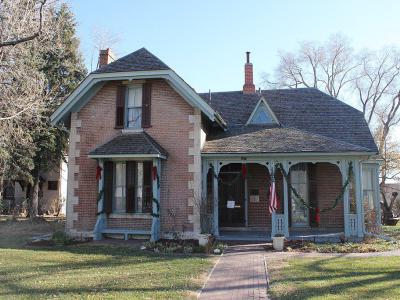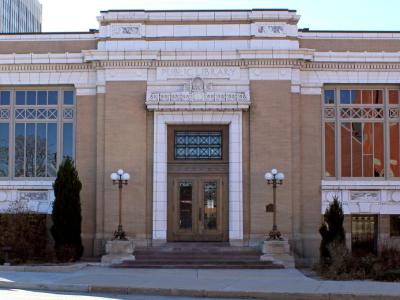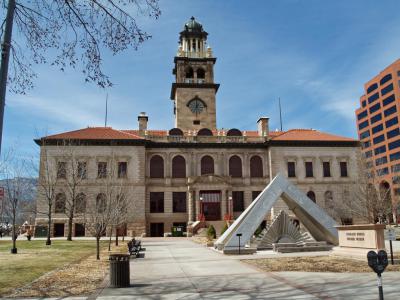Colorado Springs Downtown Walking Tour (Self Guided), Colorado Springs
Colorado Springs, or simply "The Springs", is a city with a fascinating blend of eventful past and scenic natural beauty.
Throughout its history, Colorado Springs has evolved from a gold rush town into a significant military and educational center. The region that would become Colorado Springs was initially inhabited by the Ute, Arapaho, and Cheyenne peoples and became part of the United States through the Louisiana Purchase of 1803. By the early 1870s, the area had attracted so many English immigrants that it was nicknamed "Little London."
Originally envisioned as a high-quality resort community, the town was established in 1871 by General William Jackson Palmer, an American Civil War veteran and civil engineer. His vision of wide streets and lush, open spaces, influenced Colorado Springs' early layout and is still evident today. The town's name, derived from the nearby mineral springs and majestic backdrop of the Rocky Mountains, hints at the restorative promise that drew early visitors.
By the end of the 19th century, Colorado Springs was a booming mining exchange hub. The early 20th century saw continued development with the establishment of the Tesla Experimental Station and the beginning of aircraft flights. The city’s military significance grew during World War II and was further cemented in the Cold War era.
The late 20th century saw the growth of educational institutions and the conversion of the former Ent Air Force Base into a US Olympic training center, largely contributing to yet another moniker of Colorado Springs, "Olympic City USA."
Walking through the downtown area, you encounter several historical landmarks that echo the city's heritage. One such is the William Jackson Palmer Statue, a tribute to the city’s founder. City Hall, another significant site, reflects the city’s governance and development over the years.
The Gwynne–Love House, McAllister House Museum, and the gracefully preserved Carnegie Library further depict the city’s architectural and societal growth through the ages.
Not to be missed, St Mary's Cathedral offers a glimpse into the spiritual heritage that has been pivotal in community bonding. A visit to the Colorado Springs Pioneers Museum is essential to fully appreciate the city's journey from a mineral resort to a thriving modern city.
For those intrigued by history and charmed by picturesque landscapes, Colorado Springs offers a compelling invitation to explore its treasures. So, come and witness the legacy and beauty of Colorado Springs for yourself. This self-guided tour will lead you to the city's top attractions.
Throughout its history, Colorado Springs has evolved from a gold rush town into a significant military and educational center. The region that would become Colorado Springs was initially inhabited by the Ute, Arapaho, and Cheyenne peoples and became part of the United States through the Louisiana Purchase of 1803. By the early 1870s, the area had attracted so many English immigrants that it was nicknamed "Little London."
Originally envisioned as a high-quality resort community, the town was established in 1871 by General William Jackson Palmer, an American Civil War veteran and civil engineer. His vision of wide streets and lush, open spaces, influenced Colorado Springs' early layout and is still evident today. The town's name, derived from the nearby mineral springs and majestic backdrop of the Rocky Mountains, hints at the restorative promise that drew early visitors.
By the end of the 19th century, Colorado Springs was a booming mining exchange hub. The early 20th century saw continued development with the establishment of the Tesla Experimental Station and the beginning of aircraft flights. The city’s military significance grew during World War II and was further cemented in the Cold War era.
The late 20th century saw the growth of educational institutions and the conversion of the former Ent Air Force Base into a US Olympic training center, largely contributing to yet another moniker of Colorado Springs, "Olympic City USA."
Walking through the downtown area, you encounter several historical landmarks that echo the city's heritage. One such is the William Jackson Palmer Statue, a tribute to the city’s founder. City Hall, another significant site, reflects the city’s governance and development over the years.
The Gwynne–Love House, McAllister House Museum, and the gracefully preserved Carnegie Library further depict the city’s architectural and societal growth through the ages.
Not to be missed, St Mary's Cathedral offers a glimpse into the spiritual heritage that has been pivotal in community bonding. A visit to the Colorado Springs Pioneers Museum is essential to fully appreciate the city's journey from a mineral resort to a thriving modern city.
For those intrigued by history and charmed by picturesque landscapes, Colorado Springs offers a compelling invitation to explore its treasures. So, come and witness the legacy and beauty of Colorado Springs for yourself. This self-guided tour will lead you to the city's top attractions.
How it works: Download the app "GPSmyCity: Walks in 1K+ Cities" from Apple App Store or Google Play Store to your mobile phone or tablet. The app turns your mobile device into a personal tour guide and its built-in GPS navigation functions guide you from one tour stop to next. The app works offline, so no data plan is needed when traveling abroad.
Colorado Springs Downtown Walking Tour Map
Guide Name: Colorado Springs Downtown Walking Tour
Guide Location: USA » Colorado Springs (See other walking tours in Colorado Springs)
Guide Type: Self-guided Walking Tour (Sightseeing)
# of Attractions: 14
Tour Duration: 3 Hour(s)
Travel Distance: 4.1 Km or 2.5 Miles
Author: DanaOffice
Sight(s) Featured in This Guide:
Guide Location: USA » Colorado Springs (See other walking tours in Colorado Springs)
Guide Type: Self-guided Walking Tour (Sightseeing)
# of Attractions: 14
Tour Duration: 3 Hour(s)
Travel Distance: 4.1 Km or 2.5 Miles
Author: DanaOffice
Sight(s) Featured in This Guide:
- William Jackson Palmer Statue
- City Hall
- Giddings Building
- Tejon Street
- Acacia Park
- First Congregational Church
- Grace and St. Stephen's Episcopal Church
- Gwynne–Love House
- McAllister House Museum
- Carnegie Library
- St. Mary's Cathedral
- Phantom Canyon Brewing Company
- Alamo Hotel
- Colorado Springs Pioneers Museum
1) William Jackson Palmer Statue
The General William Jackson Palmer statue stands as a tribute to the city's founder and visionary leader. Crafted from bronze, the statue depicts General Palmer astride his beloved horse, Diablo. The idea of erecting a monument to honor General Palmer was first proposed by the Chamber of Commerce following his death in 1909. However, it wasn't until April 1923 that city voters approved the site for the statue, with Nevada and Platte Avenues serving as major thoroughfares through the city at that time.
Designed by sculptor Nathan Potter, in collaboration with prominent associate Chester French, the statue was formally dedicated on September 2, 1929. Its location sparked controversy over automobile safety, as periodic calls for relocation have arisen due to concerns about traffic hazards. Nevertheless, the statue has remained a prominent fixture in the cityscape, symbolizing General Palmer's enduring legacy.
General William Jackson Palmer, born in 1836, hailed from Delaware and was a member of the Religious Society of Friends (Quakers). He played a pivotal role in the Union during the Civil War and later organized the Denver and Rio Grande Railroad. In 1871, Palmer founded the City of Colorado Springs, demonstrating his commitment to urban development and civic improvement. Throughout his life, he was instrumental in advancing various enterprises aimed at enhancing the city's infrastructure and quality of life.
Facing southwest towards the majestic Pikes Peak, General Palmer's statue portrays him in civilian attire, capturing his enduring connection to the natural beauty and rugged landscape of Colorado. Despite minor critiques, such as the absence of a cinch on the saddle, the statue stands as a testament to General Palmer's lasting presence and impact on the development of Colorado Springs.
Designed by sculptor Nathan Potter, in collaboration with prominent associate Chester French, the statue was formally dedicated on September 2, 1929. Its location sparked controversy over automobile safety, as periodic calls for relocation have arisen due to concerns about traffic hazards. Nevertheless, the statue has remained a prominent fixture in the cityscape, symbolizing General Palmer's enduring legacy.
General William Jackson Palmer, born in 1836, hailed from Delaware and was a member of the Religious Society of Friends (Quakers). He played a pivotal role in the Union during the Civil War and later organized the Denver and Rio Grande Railroad. In 1871, Palmer founded the City of Colorado Springs, demonstrating his commitment to urban development and civic improvement. Throughout his life, he was instrumental in advancing various enterprises aimed at enhancing the city's infrastructure and quality of life.
Facing southwest towards the majestic Pikes Peak, General Palmer's statue portrays him in civilian attire, capturing his enduring connection to the natural beauty and rugged landscape of Colorado. Despite minor critiques, such as the absence of a cinch on the saddle, the statue stands as a testament to General Palmer's lasting presence and impact on the development of Colorado Springs.
2) City Hall
City Hall in Colorado Springs, stands as a symbol of local government and civic pride, housed in an architectural gem that reflects the city's rich history and heritage. The current City Hall, known as the New City Hall, represents a shift in municipal administration, while the former City Hall has been repurposed as the Pioneer's Museum, preserving its historical significance for future generations.
Constructed in 1904 by architect Thomas MacLaren, the New City Hall exemplifies the Classical Revival style, characterized by its grandeur and classical architectural elements. Built using granite and brick, the building showcases intricate detailing and craftsmanship, evoking a sense of permanence and civic authority. Situated alongside the post office and former courthouse, City Hall occupies a prominent position in the city's landscape, embodying the spirit of civic governance and public service.
The site of City Hall holds historical significance, as it was once part of the territory donated by Stratton, a prominent developer associated with the gold strike, who acquired the land from General William Palmer, the founder of Colorado Springs. This connection to the city's early pioneers and visionaries underscores the importance of City Hall as a cornerstone of Colorado Springs' development and growth. Today, City Hall serves as a focal point for municipal operations, providing essential services and resources to residents while honoring the legacy of those who shaped the city's destiny.
Constructed in 1904 by architect Thomas MacLaren, the New City Hall exemplifies the Classical Revival style, characterized by its grandeur and classical architectural elements. Built using granite and brick, the building showcases intricate detailing and craftsmanship, evoking a sense of permanence and civic authority. Situated alongside the post office and former courthouse, City Hall occupies a prominent position in the city's landscape, embodying the spirit of civic governance and public service.
The site of City Hall holds historical significance, as it was once part of the territory donated by Stratton, a prominent developer associated with the gold strike, who acquired the land from General William Palmer, the founder of Colorado Springs. This connection to the city's early pioneers and visionaries underscores the importance of City Hall as a cornerstone of Colorado Springs' development and growth. Today, City Hall serves as a focal point for municipal operations, providing essential services and resources to residents while honoring the legacy of those who shaped the city's destiny.
3) Giddings Building
The Giddings Building stands as a testament to the entrepreneurial spirit and enduring success of one of the city's most prominent business ventures. Founded by Mr. and Mrs. Edwin W. Giddings in the late 19th century, Giddings Brothers & Co. initially began as a dry goods store on Tejon Street in 1874. As the business flourished, the need for expanded space became evident, leading to the acquisition of lots at the current site of the Giddings Building.
Constructed in several phases, the Giddings Building initially comprised a section with the dry goods store occupying the ground floor and offices on the upper floors. Remarkably, upon completion, it stood as the tallest building in Colorado Springs, a testament to the Giddings' vision and ambition. Over time, the store expanded to occupy the entire space, reflecting its growing success and influence in the community.
The architectural style of the Giddings Building is characterized by its Romanesque Revival design, exemplified by its large, rectangular brick structure. Modern additions, such as wrought iron balconies, have been incorporated to accommodate the building's current use, with the upper stories serving as residences. Recognized for its historical and architectural significance, the Giddings Building is listed in the National Register of Historic Places, serving as a tangible reminder of Colorado Springs' commercial and entrepreneurial heritage.
Constructed in several phases, the Giddings Building initially comprised a section with the dry goods store occupying the ground floor and offices on the upper floors. Remarkably, upon completion, it stood as the tallest building in Colorado Springs, a testament to the Giddings' vision and ambition. Over time, the store expanded to occupy the entire space, reflecting its growing success and influence in the community.
The architectural style of the Giddings Building is characterized by its Romanesque Revival design, exemplified by its large, rectangular brick structure. Modern additions, such as wrought iron balconies, have been incorporated to accommodate the building's current use, with the upper stories serving as residences. Recognized for its historical and architectural significance, the Giddings Building is listed in the National Register of Historic Places, serving as a tangible reminder of Colorado Springs' commercial and entrepreneurial heritage.
4) Tejon Street
Tejon Street stands out as a vibrant hub for shopping, dining, and nightlife, drawing locals and visitors alike with its energetic atmosphere and diverse offerings. As the main artery of Downtown Colorado Springs, Tejon Street is a bustling thoroughfare lined with an array of shops, restaurants, and bars, creating an enticing destination for exploration.
The street's grid design, intersected by large boulevards and wide avenues, contributes to its accessibility and bustling ambiance. Visitors can easily navigate the area on foot, meandering through the eclectic mix of storefronts and eateries that line both sides of Tejon Street. From trendy boutiques and art galleries to cozy cafes and upscale dining establishments, there's something to suit every taste and preference along this vibrant stretch.
In addition to its daytime allure, Tejon Street comes alive after dark, transforming into a lively nightlife destination. The street's bars, pubs, and entertainment venues offer an array of options for revelers seeking a night out on the town. Whether you're in the mood for craft cocktails, live music, or late-night bites, Tejon Street delivers an exciting array of options to satisfy your cravings and keep the energy flowing well into the evening.
The street's grid design, intersected by large boulevards and wide avenues, contributes to its accessibility and bustling ambiance. Visitors can easily navigate the area on foot, meandering through the eclectic mix of storefronts and eateries that line both sides of Tejon Street. From trendy boutiques and art galleries to cozy cafes and upscale dining establishments, there's something to suit every taste and preference along this vibrant stretch.
In addition to its daytime allure, Tejon Street comes alive after dark, transforming into a lively nightlife destination. The street's bars, pubs, and entertainment venues offer an array of options for revelers seeking a night out on the town. Whether you're in the mood for craft cocktails, live music, or late-night bites, Tejon Street delivers an exciting array of options to satisfy your cravings and keep the energy flowing well into the evening.
5) Acacia Park
Acacia Park holds a special place in the heart of Colorado Springs, as it stands as the city's first park, generously donated by its founder, General William Jackson Palmer, in 1871. Alongside Antlers and Alamo Square Parks, Acacia Park forms a trio of historic downtown public spaces that have served as beloved recreational hubs for the community for more than a century.
As part of the Downtown Historic Parks Improvement Project, Acacia Park underwent a revitalization effort aimed at enhancing its amenities and appeal to the public. The project reimagined the park to include modern features such as a permanent ice arena, an elevated viewing deck, and an artificial turf amphitheater. These additions have transformed Acacia Park into a vibrant and dynamic urban oasis, offering diverse recreational opportunities for people of all ages.
One of the recent highlights of Acacia Park's transformation is the completion of a new playground in 2022. The playground features an artistic Ninja Warrior-like climbing structure, a tot lot with colorful rubberized features, a slide, and a spinner, providing endless fun and excitement for children and families. Additionally, visitors can enjoy amenities such as picnic tables, Uncle Wilber's Fountain, and lush shade trees, making Acacia Park an ideal spot for picnics, relaxation, and outdoor play. The park's bandshell also serves as a venue for free summer concerts, adding to its appeal as a vibrant cultural and recreational hub in downtown Colorado Springs.
As part of the Downtown Historic Parks Improvement Project, Acacia Park underwent a revitalization effort aimed at enhancing its amenities and appeal to the public. The project reimagined the park to include modern features such as a permanent ice arena, an elevated viewing deck, and an artificial turf amphitheater. These additions have transformed Acacia Park into a vibrant and dynamic urban oasis, offering diverse recreational opportunities for people of all ages.
One of the recent highlights of Acacia Park's transformation is the completion of a new playground in 2022. The playground features an artistic Ninja Warrior-like climbing structure, a tot lot with colorful rubberized features, a slide, and a spinner, providing endless fun and excitement for children and families. Additionally, visitors can enjoy amenities such as picnic tables, Uncle Wilber's Fountain, and lush shade trees, making Acacia Park an ideal spot for picnics, relaxation, and outdoor play. The park's bandshell also serves as a venue for free summer concerts, adding to its appeal as a vibrant cultural and recreational hub in downtown Colorado Springs.
6) First Congregational Church
First Congregational Church stands as a testament to both the enduring spirit of its community and the rich history of Congregationalism in the United States. Established in 1874, the church has been a beacon of open-minded worship and community engagement for over a century. Congregationalism, with its roots dating back to the 1600s, has played a significant role in shaping the landscape of higher education, with parishioners contributing to the founding of esteemed institutions such as Harvard, Yale, and Colorado College.
Designed by architect Henry Rutgers Marshall in the Romanesque style, First Congregational Church is a striking architectural landmark in Colorado Springs. Constructed of Wall Mountain Tuff, a type of rhyolite, the church boasts a distinctive appearance that reflects both its historical significance and architectural prowess. Its design captures the essence of Romanesque architecture, characterized by its rounded arches, sturdy columns, and ornate detailing.
In recognition of its architectural and historical significance, First Congregational Church was declared a Historic Site of Colorado Springs on October 31, 2002. Today, the church continues to welcome worshippers from all walks of life, embodying the principles of inclusivity, compassion, and spiritual growth that have guided its community for generations.
Designed by architect Henry Rutgers Marshall in the Romanesque style, First Congregational Church is a striking architectural landmark in Colorado Springs. Constructed of Wall Mountain Tuff, a type of rhyolite, the church boasts a distinctive appearance that reflects both its historical significance and architectural prowess. Its design captures the essence of Romanesque architecture, characterized by its rounded arches, sturdy columns, and ornate detailing.
In recognition of its architectural and historical significance, First Congregational Church was declared a Historic Site of Colorado Springs on October 31, 2002. Today, the church continues to welcome worshippers from all walks of life, embodying the principles of inclusivity, compassion, and spiritual growth that have guided its community for generations.
7) Grace and St. Stephen's Episcopal Church
Grace and Saint Stephen's Episcopal Church holds a rich history dating back to its founding in 1872. Over the years, the church has undergone several stages of development, resulting in the impressive building complex that stands today. The original structure, completed in 1895, continues to serve as the parish hall, reflecting the church's longstanding presence in the community.
One of the most notable features of Grace and Saint Stephen's Episcopal Church is its tower building, a striking architectural gem reminiscent of Magdalen College at Oxford University in England. Designed by renowned architects Frohman, Robb, and Little, who also contributed to notable projects such as Saint Thomas Church in New York City and the Washington National Cathedral in Washington D.C., the tower building stands as a testament to their skill and vision. Completed in 1926, this iconic structure adds to the church's allure and grandeur.
Beyond its architectural significance, Grace and Saint Stephen's Episcopal Church serves as a spiritual and communal hub for its members and the broader community. With its rich history, diverse congregation, and commitment to faith and service, the church remains a cherished institution in Colorado Springs.
One of the most notable features of Grace and Saint Stephen's Episcopal Church is its tower building, a striking architectural gem reminiscent of Magdalen College at Oxford University in England. Designed by renowned architects Frohman, Robb, and Little, who also contributed to notable projects such as Saint Thomas Church in New York City and the Washington National Cathedral in Washington D.C., the tower building stands as a testament to their skill and vision. Completed in 1926, this iconic structure adds to the church's allure and grandeur.
Beyond its architectural significance, Grace and Saint Stephen's Episcopal Church serves as a spiritual and communal hub for its members and the broader community. With its rich history, diverse congregation, and commitment to faith and service, the church remains a cherished institution in Colorado Springs.
8) Gwynne–Love House
The Gwynne–Love House, alternatively known as the Goldmuntz Cascade House, stands as a testament to Colorado Springs' rich architectural heritage. Recognized on both the National Register of Historic Places and the Colorado State Register of Historic Properties since 1987, this house is nestled in central Colorado Springs atop a bluff overlooking Monument Valley Park. Its proximity to notable landmarks such as Colorado College and the Colorado Springs Fine Arts Center adds to its historical significance.
Originally commissioned by Edmiston Gwynne in 1886, the house was designed by architect Willard B. Perkins in the Queen Anne style, featuring distinct English architectural details. Despite Gwynne's untimely demise soon after completion, the house found new life as a boarding house to accommodate the influx of visitors drawn by the 1891 Cripple Creek gold discovery. In 1914, the Love family, relocating from Indianapolis, acquired the property and transformed it into a private residence, infusing it with their own legacy.
Throughout its storied history, the Gwynne–Love House has undergone various transformations, transitioning from a boarding house to a private residence and later to apartments in the 1950s. Despite these changes, the house has retained its architectural integrity and grandeur, standing as one of the few remaining stately homes from Colorado Springs' early years. With its imposing Victorian-era design, characterized by Queen Anne forms and English detailing, the Gwynne–Love House continues to captivate visitors with its timeless charm and historical significance.
Originally commissioned by Edmiston Gwynne in 1886, the house was designed by architect Willard B. Perkins in the Queen Anne style, featuring distinct English architectural details. Despite Gwynne's untimely demise soon after completion, the house found new life as a boarding house to accommodate the influx of visitors drawn by the 1891 Cripple Creek gold discovery. In 1914, the Love family, relocating from Indianapolis, acquired the property and transformed it into a private residence, infusing it with their own legacy.
Throughout its storied history, the Gwynne–Love House has undergone various transformations, transitioning from a boarding house to a private residence and later to apartments in the 1950s. Despite these changes, the house has retained its architectural integrity and grandeur, standing as one of the few remaining stately homes from Colorado Springs' early years. With its imposing Victorian-era design, characterized by Queen Anne forms and English detailing, the Gwynne–Love House continues to captivate visitors with its timeless charm and historical significance.
9) McAllister House Museum (must see)
The McAllister House Museum stands as a testament to the legacy of Major Henry McAllister and the rich history of Colorado Springs. Major McAllister played a pivotal role in the early establishment of the city, and his former home, a small Victorian-era cottage, now serves as a museum dedicated to preserving the heritage of the region. In 1961, the National Society of the Colonial Dames of America in Colorado, in collaboration with the El Pomar Foundation and Shepard’s Citations, acquired the property and transformed it into a museum.
Visitors to the McAllister House Museum are transported back in time as they step through the doors of this historic dwelling. The interior is adorned with period furniture and decor, offering a glimpse into life in the late 19th century. One notable feature of the museum is the children's room, which is filled with an array of dolls and toys from the 1800s, providing an immersive experience for visitors of all ages.
In addition to its historical significance, the McAllister House Museum also features a gift shop where visitors can browse and purchase books, jewelry, postcards, and other memorabilia related to the museum's exhibits and the broader history of Colorado Springs.
Visitors to the McAllister House Museum are transported back in time as they step through the doors of this historic dwelling. The interior is adorned with period furniture and decor, offering a glimpse into life in the late 19th century. One notable feature of the museum is the children's room, which is filled with an array of dolls and toys from the 1800s, providing an immersive experience for visitors of all ages.
In addition to its historical significance, the McAllister House Museum also features a gift shop where visitors can browse and purchase books, jewelry, postcards, and other memorabilia related to the museum's exhibits and the broader history of Colorado Springs.
10) Carnegie Library
Situated atop a hill with sweeping views of Pikes Peak, the Carnegie Library owes its existence to the generosity of General William Jackson Palmer, the town's esteemed founder, who donated the site for its construction. Andrew Carnegie, a renowned philanthropist, provided the substantial sum of $60,000 to cover the construction costs.
Designed by Calvin Kiessling, associated with the prestigious Boston firm Shepley, Rutan, and Coolidge, the Carnegie Library boasts a Classical Revival style with Roman influences, a hallmark of Carnegie libraries of the time. The design prioritizes optimal lighting and picturesque views of the Front Range through strategically placed windows. The building's aesthetic is further enhanced by ornate wrought iron embellishments crafted by the local Hassell Iron Works.
Since its completion in 1905, the Carnegie Library has served as a beacon of knowledge and culture, continuously operating as a library. In 1968, recognizing the need for expansion, a 60,000 square foot addition was constructed facing Cascade Avenue. This addition, known as the Palmer Wing, now houses the library's special collections and Local History resources, including invaluable records of General Palmer's Colorado Springs Company and the papers of local architect Thomas MacLaren. The Carnegie Library's historical and architectural significance is further underscored by its listing in the National Register of Historic Places.
Designed by Calvin Kiessling, associated with the prestigious Boston firm Shepley, Rutan, and Coolidge, the Carnegie Library boasts a Classical Revival style with Roman influences, a hallmark of Carnegie libraries of the time. The design prioritizes optimal lighting and picturesque views of the Front Range through strategically placed windows. The building's aesthetic is further enhanced by ornate wrought iron embellishments crafted by the local Hassell Iron Works.
Since its completion in 1905, the Carnegie Library has served as a beacon of knowledge and culture, continuously operating as a library. In 1968, recognizing the need for expansion, a 60,000 square foot addition was constructed facing Cascade Avenue. This addition, known as the Palmer Wing, now houses the library's special collections and Local History resources, including invaluable records of General Palmer's Colorado Springs Company and the papers of local architect Thomas MacLaren. The Carnegie Library's historical and architectural significance is further underscored by its listing in the National Register of Historic Places.
11) St. Mary's Cathedral (must see)
Saint Mary's Cathedral stands as a prominent landmark in Colorado Springs, serving as the seat of the Diocese of Colorado Springs and holding a distinguished place in the city's architectural and religious heritage. Designed by architects Pease and Barber in the Gothic Revival style, the cathedral's construction began in 1891, with the lower level completed that same year. Over the following years, the cathedral underwent successive phases of expansion and embellishment, culminating in its dedication on December 19, 1998.
One of the notable features of Saint Mary's Cathedral is its bell towers, which were added in 1902, followed by the completion of the spires in 1907. During a redecorating project from 1902 to 1904, Gothic arched ceilings, six side-aisle windows, and electric lights were installed, enhancing the cathedral's grandeur and architectural splendor. Subsequent renovations in 1916 saw the installation of a new pipe organ, further enriching the cathedral's musical heritage and worship experience.
In 1983, Blessed John Paul II established the Diocese of Colorado Springs, with Saint Mary's chosen as its cathedral. This decision affirmed the cathedral's significance as a spiritual and administrative center for the Catholic community in the region.
One of the notable features of Saint Mary's Cathedral is its bell towers, which were added in 1902, followed by the completion of the spires in 1907. During a redecorating project from 1902 to 1904, Gothic arched ceilings, six side-aisle windows, and electric lights were installed, enhancing the cathedral's grandeur and architectural splendor. Subsequent renovations in 1916 saw the installation of a new pipe organ, further enriching the cathedral's musical heritage and worship experience.
In 1983, Blessed John Paul II established the Diocese of Colorado Springs, with Saint Mary's chosen as its cathedral. This decision affirmed the cathedral's significance as a spiritual and administrative center for the Catholic community in the region.
12) Phantom Canyon Brewing Company
Phantom Canyon Brewing Company, founded in December 1993, is the oldest brewery in Colorado Springs. It's located in the historic Cheyenne Building, built in 1901, and has become a significant part of the city's craft beer scene. Originally, the building served as the local offices of the Chicago, Rock Island and Pacific Railroad, and it underwent a transformation in 1909, reopening as The Cheyenne Hotel, which remained under the Shafer family's ownership until 1963. Today, it's recognized as the first downtown restaurant listed on the National Register of Historical Places, situated prominently at the intersection of Pikes Peak and Cascade.
The Cheyenne Building takes its name from Cheyenne Mountain and features Chief Two Moons of the Cheyenne Indian Tribe at its front entrance, paying homage to its rich history. The brewery spans multiple floors, with the second floor hosting the Phantom Canyon Billiard Hall-a hub for pool enthusiasts and late-night entertainment, offering various options for amusement. On the other hand, the third floor Banquet Hall, newly restored in December 2001, provides an elegant venue for private parties and business gatherings. It boasts scenic mountain views, high ceilings, and a fully equipped bar and kitchen. Phantom Canyon Brewing Company isn't just a brewery; it's a place where history, craft beer, and community come together.
The Cheyenne Building takes its name from Cheyenne Mountain and features Chief Two Moons of the Cheyenne Indian Tribe at its front entrance, paying homage to its rich history. The brewery spans multiple floors, with the second floor hosting the Phantom Canyon Billiard Hall-a hub for pool enthusiasts and late-night entertainment, offering various options for amusement. On the other hand, the third floor Banquet Hall, newly restored in December 2001, provides an elegant venue for private parties and business gatherings. It boasts scenic mountain views, high ceilings, and a fully equipped bar and kitchen. Phantom Canyon Brewing Company isn't just a brewery; it's a place where history, craft beer, and community come together.
13) Alamo Hotel
Constructed in 1886, the Alamo Hotel is listed on the National Register of Historic Places, recognizing its significance in the local community and beyond. Over the years, the hotel underwent several renovations, with notable updates completed in 1890 and 1899, reflecting the evolving needs and tastes of travelers during the late 19th century.
Originally serving as a traveling stop for ordinary travelers and salesmen, the Alamo Hotel played a vital role in facilitating commerce and leisure travel in the region. Its strategic location made it a convenient resting place for weary travelers seeking respite along their journeys. However, as the hospitality industry evolved and transportation networks expanded, the hotel's role shifted over time.
In 1968, the Alamo Hotel was converted into apartments, marking a new chapter in its storied history. Despite this transformation, the building retained its historic charm and architectural integrity, offering residents a unique living experience steeped in nostalgia and character. In addition to serving as residential units, the property now houses shops, adding vibrancy and economic activity to the surrounding neighborhood.
Following its acquisition by the Colorado Springs Urban Renewal Authority in 1974, the Alamo Hotel underwent extensive renovations to preserve its historic character while meeting modern standards of safety and functionality. Despite the removal of certain portions of the structure during the renovation process, key architectural elements, such as the south portion and the north tower, were preserved, ensuring that the building's unique identity and historical significance endure for future generations to appreciate.
Originally serving as a traveling stop for ordinary travelers and salesmen, the Alamo Hotel played a vital role in facilitating commerce and leisure travel in the region. Its strategic location made it a convenient resting place for weary travelers seeking respite along their journeys. However, as the hospitality industry evolved and transportation networks expanded, the hotel's role shifted over time.
In 1968, the Alamo Hotel was converted into apartments, marking a new chapter in its storied history. Despite this transformation, the building retained its historic charm and architectural integrity, offering residents a unique living experience steeped in nostalgia and character. In addition to serving as residential units, the property now houses shops, adding vibrancy and economic activity to the surrounding neighborhood.
Following its acquisition by the Colorado Springs Urban Renewal Authority in 1974, the Alamo Hotel underwent extensive renovations to preserve its historic character while meeting modern standards of safety and functionality. Despite the removal of certain portions of the structure during the renovation process, key architectural elements, such as the south portion and the north tower, were preserved, ensuring that the building's unique identity and historical significance endure for future generations to appreciate.
14) Colorado Springs Pioneers Museum (must see)
Located within the former El Paso County Courthouse, the Colorado Springs Pioneers Museum stands as a cornerstone of local history and culture in Colorado Springs. Built in 1903, the elegant and historic courthouse building is surrounded by a park adorned with sculptures and a granite fountain, adding to its picturesque charm. The museum's mission is rooted in preserving the rich tapestry of the region's past, collecting artifacts, and providing meaningful interpretations to visitors.
With a collection boasting approximately 60,000 objects, the Colorado Springs Pioneers Museum offers a diverse range of artifacts that reflect the area's multifaceted history. From exquisite quilts and renowned Van Briggle art pottery to American Indian artifacts, jukeboxes, motorcycles, and baseball memorabilia, the museum's exhibits provide insight into various aspects of local life and culture. Annually, around 75,000 people visit the museum, underscoring its significance as a cultural hub within the community.
The museum's permanent exhibits delve into the history of the Pikes Peak region, offering immersive experiences that trace the area's evolution over time. Additionally, the museum hosts changing exhibits on topics of broad interest, ensuring that visitors have opportunities to explore new facets of the region's heritage with each visit. Accredited by the American Association of Museums and recognized with local and national awards for excellence, the Colorado Springs Pioneers Museum is renowned for its commitment to preserving and sharing the rich legacy of the Pikes Peak region with audiences of all ages and interests.
Editor's Note: The Colorado Springs Pioneers Museum (CSPM) is embarking on an eight-month endeavor, investing $6.2 million in a cutting-edge HVAC system installation project. Throughout this period, access to the historic 1903 El Paso County Courthouse will be temporarily suspended to the public. However, a dedicated CSPM Annex will be unveiled at the Plaza of the Rockies, showcasing exciting new exhibits for visitors to enjoy.
Operating hours for the CSPM Annex are Tuesday through Saturday, from 10 a.m. to 5 p.m. The annex is conveniently situated at 121 S. Tejon Street, Suite 100, within the Plaza of the Rockies complex.
With a collection boasting approximately 60,000 objects, the Colorado Springs Pioneers Museum offers a diverse range of artifacts that reflect the area's multifaceted history. From exquisite quilts and renowned Van Briggle art pottery to American Indian artifacts, jukeboxes, motorcycles, and baseball memorabilia, the museum's exhibits provide insight into various aspects of local life and culture. Annually, around 75,000 people visit the museum, underscoring its significance as a cultural hub within the community.
The museum's permanent exhibits delve into the history of the Pikes Peak region, offering immersive experiences that trace the area's evolution over time. Additionally, the museum hosts changing exhibits on topics of broad interest, ensuring that visitors have opportunities to explore new facets of the region's heritage with each visit. Accredited by the American Association of Museums and recognized with local and national awards for excellence, the Colorado Springs Pioneers Museum is renowned for its commitment to preserving and sharing the rich legacy of the Pikes Peak region with audiences of all ages and interests.
Editor's Note: The Colorado Springs Pioneers Museum (CSPM) is embarking on an eight-month endeavor, investing $6.2 million in a cutting-edge HVAC system installation project. Throughout this period, access to the historic 1903 El Paso County Courthouse will be temporarily suspended to the public. However, a dedicated CSPM Annex will be unveiled at the Plaza of the Rockies, showcasing exciting new exhibits for visitors to enjoy.
Operating hours for the CSPM Annex are Tuesday through Saturday, from 10 a.m. to 5 p.m. The annex is conveniently situated at 121 S. Tejon Street, Suite 100, within the Plaza of the Rockies complex.
Walking Tours in Colorado Springs, Colorado
Create Your Own Walk in Colorado Springs
Creating your own self-guided walk in Colorado Springs is easy and fun. Choose the city attractions that you want to see and a walk route map will be created just for you. You can even set your hotel as the start point of the walk.
Colorado College Historical Buildings Walking Tour
Founded in 1874, Colorado College stands out as one of the earliest institutions in Colorado to confer academic degrees. It was established through the efforts of General William Palmer, the founder of Colorado Springs, and Henry McAllister, a director of the Colorado Springs Company, both of whom contributed land along Cascade Avenue for the campus, setting the foundation for the college's... view more
Tour Duration: 2 Hour(s)
Travel Distance: 2.4 Km or 1.5 Miles
Tour Duration: 2 Hour(s)
Travel Distance: 2.4 Km or 1.5 Miles
The Most Popular Cities
/ view all




